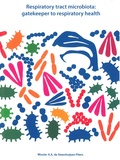Respiratory tract microbiota
gatekeeper to respiratory health

Steenhuijsen Piters, Wouter de
- Promoter:
- Prof.dr. E.A.M. (Lieke) Sanders & prof.dr. D. (Debby) Bogaert
- Co-promoter:
- Dr. M.A. (Marlies) van Houten
- Research group:
- Sanders
- Date:
- October 25, 2018
- Time:
- 14:30 h
Summary
Introduction
Respiratory tract infections (RTIs) are responsible for a large burden of disease, with the highest incidence in children and elderly adults. These age groups are at increased risk of developing respiratory infections and once established, they are more likely to die from the infection, especially when the lower airways are involved (i.e. lower RTI [LRTI] or pneumonia). Yearly, approximately 900,000 children die because of pneumonia globally, making up for ~15% of all deaths in children under the age of 5 years. Furthermore, development of these lower RTIs early in life increases the risk of wheezing disease. Upper respiratory tract infections, like otitis media, cause considerable morbidity and are a major reason for (inappropriate) antibiotic prescriptions, which come at the cost of antimicrobial resistance and perturbations of resident bacterial communities.
Infectious diseases, like RTIs, have long been considered in isolation and viewed within the Koch’s one-host one-pathogen paradigm. However, the human body is colonized by vast numbers of specialised bacterial communities, conjointly referred to as the bacterial microbiota. The advent of next-generation sequencing techniques such as 454 and later Illumina MiSeq sequencing, signalled the start of a systems biology era, enabling us to characterise the entirety of the microbiota. Among others, the microbiota is involved in steering immune development, setting an individual on a trajectory towards or away from disease. In addition, diverse resident bacterial communities provide us with ‘colonization resistance’, therewith protecting the human host from incoming or blooming pathogens.
Outline of this thesis
The research described in this thesis is divided into two parts, each of which is introduced by a review. In part 1, the central theme is the healthy respiratory microbiota in children and young adults. We pose that the respiratory tract microbiota composition early in life may have profound repercussions later in life with regard to RTI burden of disease. The research projects composing part 2 revolve around the associations between upper respiratory tract microbiota composition and acute RTIs in infants and older adults. We hypothesize that changes in the respiratory tract microbiota composition are associated with respiratory disease.
First, in chapter 2, we review the current body of evidence on the healthy respiratory tract microbiota. We focus on the function of the healthy respiratory tract microbiota, which includes in-depth discussions on how the microbiota impacts organogenesis and host immune system maturation. Furthermore, emphasis is being paid to the lung microbiota, as well as the respiratory tract virome and mycobiome. In chapter 3, we characterise the healthy respiratory tract microbiota development in a cohort of 112 healthy, unselected children in whom we collected respiratory tract samples at regular time points over the first year of life, as well as at the time of RTIs (maximum 14 samples). We were able to demonstrate that microbiota changes within the first month of life are associated with long term susceptibility to respiratory infections. In addition, we showed that the microbiota may form the intermediate connecting host and environmental factors such as birth mode, feeding type, crowding conditions and antibiotic usage and development of infections. Following, in chapter 4 we describe the impact of viral co-infection on the acquisition and density of a common respiratory pathogen, i.e. pneumococcus. We describe two randomized controlled trials where we experimentally challenged healthy adult volunteers with S. pneumoniae, combined with antecedent (i.e. before pneumococcal challenge) or concurrent (i.e. after pneumococcal challenge) vaccination with live-attenuated influenzavirus (Fluenz Tetra, AstraZeneca, UK or FluMist, MedImmune, Netherlands). These trials allowed us to study pneumococcal acquisition and density in the context of a mild viral co-infection, focussing on the impact of baseline nasal microbiota (i.e. before pneumococcal exposure and vaccination) on this process in the next chapter (chapter 5). Though data on pneumococcal carriage in relation to (mild) viral infection are available from studies in mice, no study to date has studied the pneumococcal dynamics in relation with LAIV in an experimental human challenge setting, let alone the impact of the nasal microbiota on this interaction. Our results suggested that LAIV may transiently increase nasopharyngeal density of S. pneumoniae when administered prior to pneumococcal exposure, but not when the vaccine was given after pneumococcal challenge. Nasal microbiota profiles at baseline were significantly associated with consecutive pneumococcal acquisition and density.
The research projects composing part 2 revolve around the associations between upper respiratory tract microbiota composition and acute RTIs in infants and older adults. First, in chapter 6, we review the upper respiratory tract composition installation and development using an ecological theoretical framework. Subsequently, ecological and microbiota changes in acute respiratory tract infectious disease processes, such as pneumonia and acute otitis media, are investigated. We theorize that a reduction in colonization resistance is the main mode of action by which the microbiota controls infectious disease susceptibility. In line, in chapter 7, we describe the difference in oropharyngeal microbiota composition between healthy elderly and elderly pneumonia patients using a large cohort with over 400 individuals. Strikingly, we found that not the presence of known pathogens, but rather the absence of specific commensal microbiota members discriminates between health and disease. Using an adult control cohort, we were able to capture age-dependent changes in microbiota that co-occurred with pneumonia development, which were in line with the changes related to disease. In chapter 8, we characterise the nasopharyngeal microbiota and host immune response in healthy children and children with a mild or severe respiratory syncytial virus (RSV) infection. Our data suggested that interactions between RSV and nasopharyngeal microbiota might modulate the host immune response, potentially impacting clinical RSV disease severity.
Finally, in chapter 9 we provide a summary and discussion of our findings in the context of current literature, concluding with recommendations for future studies on respiratory microbiota research.